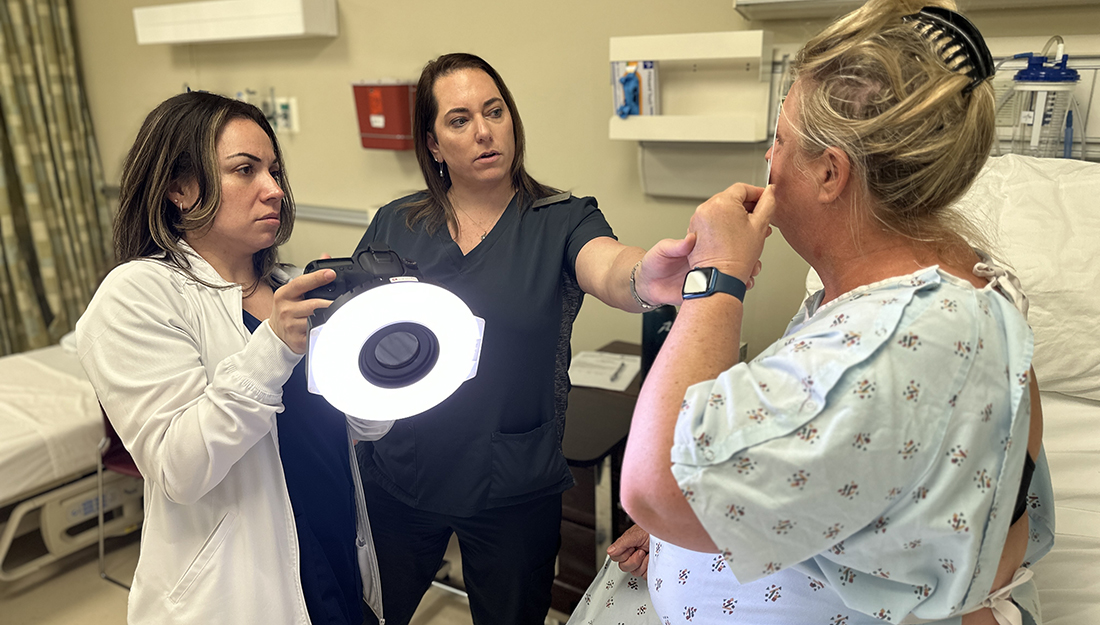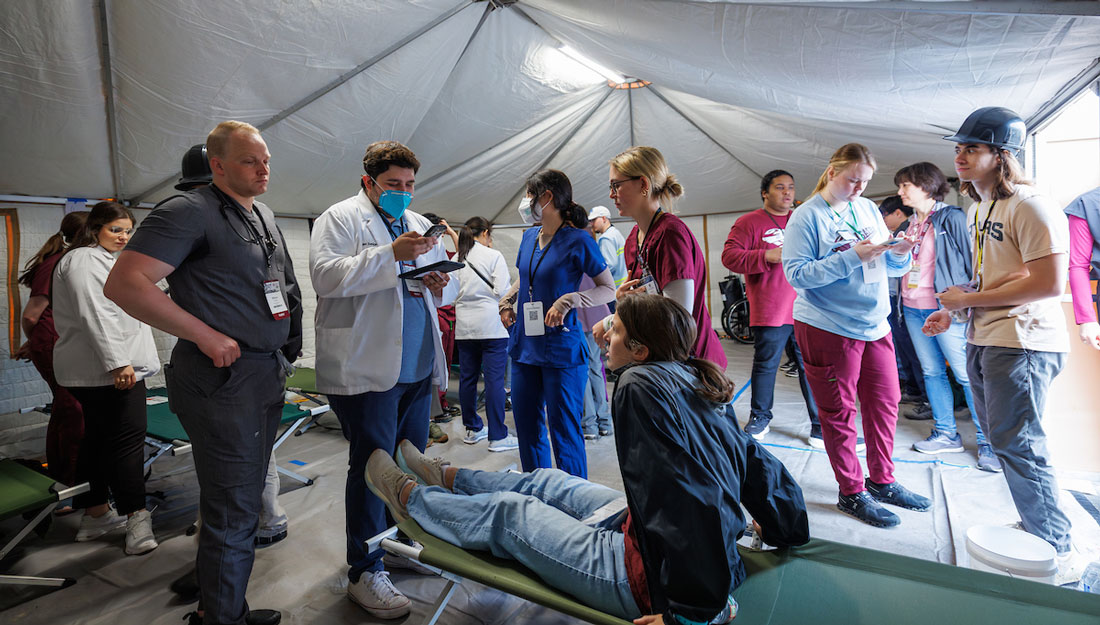- Christina Sumners
- Medicine, Nursing, Show on VR homepage
A new medical model: Patients who use their bodies to teach
Specially trained instructors teach students the fundamentals of a physical exam, with their own bodies

Every profession has a basic skill it seems they should just know. Architects can draw a blueprint, lawyers can write a brief and physicians and nurses can perform a physical exam.
But how do they learn those skills?
At the Texas A&M Health Science Center, future physicians and nurses learn with the help of specially trained teaching associates who teach not only the most effective ways to perform these exams, but also how to make the process as comfortable as possible for the patient. And even more than comfort, students are given new tools for empowering and educating their patients in ways like never before.
Male urogenital teaching associates (MUTAs) teach future health care providers how to perform a routine male genital-rectal examination. Their female counterparts, called gynecologic teaching associates (GTAs), teach the entire well-woman exam, including breast and pelvic examination. “They use their own bodies to train students,” said Jerry Livingston, Ph.D., M.S.N, RN, assistant professor at the Texas A&M College of Medicine. “Because these two types of exams are so dreaded by so many people, it is especially important to teach the future health care providers how to make their patients feel comfortable both mentally and physically.” MUTAs and GTAs also provide real-time feedback, helping students practice their skills in a supportive and safe environment.
“MUTAs and GTAs act as both model and independent instructor,” said Chelsea Knutson, BSN, R.N., a simulation coordinator at the Texas A&M Clinical Learning Resource Center (CLRC), who runs the MUTA and GTA programs. “They allow the student to actually perform the exam on them while giving the student immediate feedback. MUTAs and GTAs create a low-stress learning environment; the fear of hurting a patient has been eliminated—MUTAs and GTAs know their bodies well, and with the immediate feedback they are able to give, can prevent any harm from coming their way.”
This is a better system than using untrained volunteers as the models with a clinical instructor to perform the exams and train the students—and far more instructive than when, in decades past, students’ training was done on a rudimentary mannequin. (Advanced mannequins are still used in conjunction with MUTAs and GTAs, but they are no longer the primary teaching method.)
The MUTA and GTA teaching model helps maximize the physicians’ time, and it ensures that all students are taught a single, standardized way of performing an exam that is based on evidence-based practice. “If you get 25 physicians teaching different groups of students, you’ll get several different ways of doing an exam,” Dr. Livingston said. “Having MUTAs and GTAs teach the students eliminates this issue.” In fact, a report by the the Association of Professors of Gynecology and Obstetrics indicated that GTAs are the best way to teach pelvic and breast exams.
GTAs teach sitting up so they can better communicate with the students—and so the students can learn how important it is that they can see their patient’s face. “You can absolutely do an exam with the patient sitting up at a 90-degree angle,” Knutson said. “It may seem a little strange at first, but even during a real routine exam, the person should never be lying flat on the table. Patient empowerment and interaction is a big part of what we’re teaching.”
They do so by imparting new vocabulary and communication skills to help ease the anxiety of the patient.
“If patients don’t come in to have these exams because they feel uncomfortable, we’re not really doing our job as health care providers,” said Laura Livingston, M.A., associate director of the CLRC. “We’re teaching our students to be the best patient stewards possible—and that also means reducing the mental stress of the situation so people keep coming in for these exams.”
The detailed information and feedback students learn from MUTAs and GTAs allows them to approach exams in an entirely new way. Patients are no longer seen as a “problem visit” and students aren’t just trying to find “what’s wrong,” instead the intricacies of the feedback from these specialized instructors allows students to learn how to teach patients about their own bodies and to encourage two-way communication with their patients.
Something as simple as teaching new vocabulary to students can open a lot of doors to this approach to health: an approach where patient and physician work together for the good of the patient.
No longer is the cover referred to as a “sheet,” but now as a drape. The word “stirrups” is no longer used for where patients place their feet. No longer are patients asked to “lie down.”
Beyond the simple uncomfortableness of these exams, they can be downright traumatic for patients who are assault and abuse survivors, or for patients who had painful experiences with previous physicians.
Although Knutson herself has a nursing degree, no medical degree is needed to become a good GTA. Before instructing students, GTAs go through 56 hours of intensive training, developed and approved by obstetricians, to become experts at teaching the exam. “I was a GTA before I was a nurse,” Knutson said. “All that’s really required is a good knowledge of your own body and a willingness to use it in this way.”
Luckily for Texas A&M students, many people do seem willing to do so.
“The program has blossomed, absolutely blossomed,” said Knutson, who was one of the first GTAs and the first trainer of other GTAs. “It started in Bryan, and it is now on all five campuses: Houston, Dallas, Round Rock and Temple, in addition to Bryan.”
“The medical and family nurse practitioner students who interact with MUTAs and GTAs always have such wonderful feedback for us,” Knutson added.
Although the GTA program at the health science center is well established, the MUTA program is still quite new, getting off the ground in February 2016. “We have stayed at the cutting edge to use everything that is out there to teach our medical students,” Dr. Livingston said. Relatively few schools have their own MUTA program, and instead rely on commercial companies to provide the MUTAs for their students.
MUTA interactions start with a 20-minute didactic portion to reinforce the significance of this type of male exam for students, who can then pass this information on to their future patients. “Women’s health care is something that is emphasized in our culture,” Knutson said. “Men’s health care appointments are far more often missed, and prostate exams are often turned into a punchline, it can be easy to forget that it’s really so important.”
The next step for the CLRC is a physical exam teaching associate (PETA) program to teach students how to perform non-gender specific portions of a medical exam. “These instructors are trained using evidence-based medicine to do assessments,” Dr. Livingston said. “They can tell the students, ‘right here is where you listen to the heart, to the lungs,’ and they can tell if the student is doing it correctly.”
“I love being able to help this program grow,” Knutson said. “It’s very rewarding to see students who are overtly nervous before their session—terrified, sweating, saucer-eyed students who have never performed a female pelvic exam or a prostate exam—walk out of their MUTA or GTA sessions smiling, happy and saying, ‘That was an AWESOME way to learn and not as scary as I thought. I can do that in clinic!’”
Media contact: media@tamu.edu


